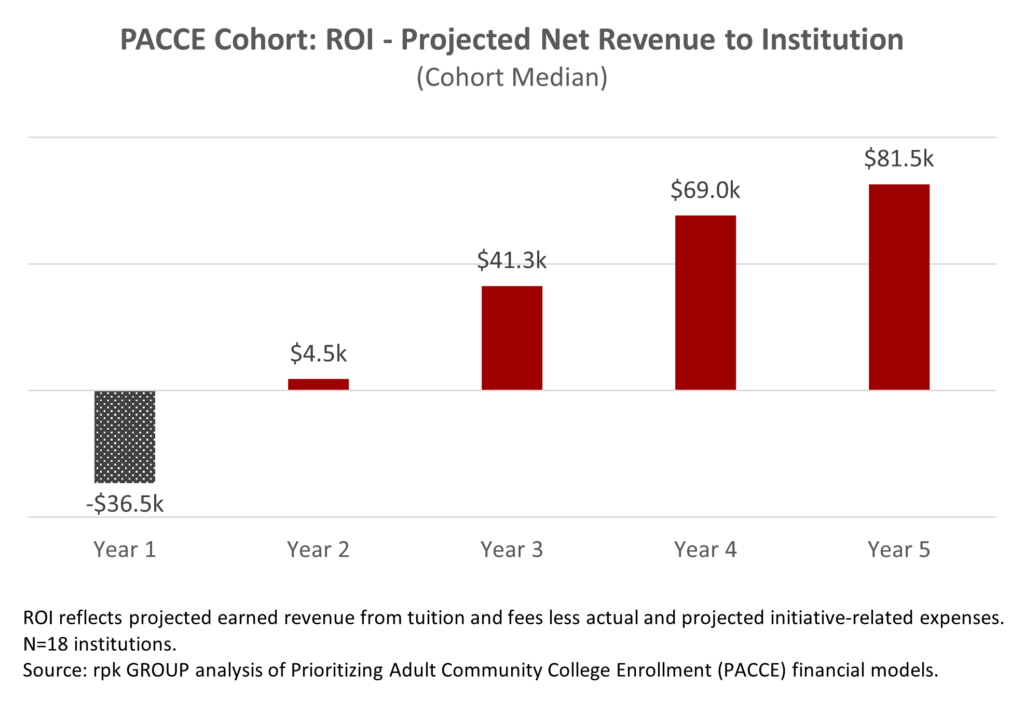By Mike Daly, Donna Desrochers, and Charlotte Pierce
As institutions continue to navigate pandemic-related enrollment declines, a new challenge looms on the horizon. Widely anticipated generational shifts are expected to result in a post-secondary ‘enrollment cliff’ beginning in 2025 as successively smaller student cohorts progress through America’s K-12 system. Naturally, there are concerns around the impact of declining demographics in traditional college-age populations; however, colleges and universities have a range of options for minimizing this impact, including reaching out to adult learners.
In 2021, 20 community colleges across eight states began implementing approaches to scale and sustain efforts geared toward this demographic through Prioritize Adult Community College Enrollment (PACCE), a two-year grant initiative funded by Lumina Foundation. Grantees shared experiences and learnings in exploring new campus enrollment strategies, offering insights for other higher education leadership teams considering new ways to recruit and retain adult students.
The PACCE initiative included programs designed to intentionally enroll Black and Hispanic/Latinx adults. Grantees’ efforts largely reflect three different types of projects:
- Campus-wide initiatives expected to boost enrollment in programs across the current academic portfolio;
- Focused initiatives intended to boost enrollment in specific academic or work preparation programs;
- and new offerings designed to specifically serve adult students.
Over an 18-month period, rpk GROUP supported these community colleges to build capacity enabling them to grow these programs in financially sustainable ways. Capacity-building strategies included guidance on creating a solid infrastructure, including policies, processes, and staff capabilities, to provide ongoing robust support for their program-centered initiatives. The identification of post-grant revenue sources and the intentional use of available resources was also an important contributor to financial sustainability. Finally, institutions focused on combining financial and student success metrics and incorporating these into good storytelling to build the institutional culture necessary to scale and sustain this work.
Throughout our team’s engagement with PACCE grantees, we observed the following key learnings:
- A multi-pronged approach leveraging communication, technology, and partnerships strengthens required infrastructure.
The PACCE colleges implemented strategies to ensure immediate interest and lasting impact of their initiatives designed to increase adult learner enrollment. Notably:
- Colleges prioritized communication improvements, including the creation of dual-language materials and evergreen resources, assessing the impact of various types of channels which led to tailored messaging to specific populations and efficiently expanding marketing strategies.
- Several grantees invested in student marketing and enrollment technologies that deepened the college’s understanding of prospective students’ pathways—from interest to application to enrollment—which reduced institutional effort and enabled students to enroll quickly and more seamlessly.
- Several colleges leveraged community partnerships and resources through the co-location of outreach offices within established community service organizations, such as local public libraries, hospitals, and childcare centers. Others adopted ‘train the trainer’ models with community staff to amplify recruitment efforts and ensure consistent messaging. These expanded outreach efforts redoubled many community college teams’ interest in becoming an even more integral part of their communities.
- Program scalability underpins financial sustainability.
Expectations around scaling enrollment in the PACCE initiatives were often conservative. But the grantees’ own projections of students and finances demonstrated that scale—not years of operation—is the driver of financial sustainability. Time alone wasn’t necessarily going to generate positive net revenue. Instead, programs needed to engage enough students to generate the revenue required to cover their costs.
Colleges’ leadership teams appreciated the foundational knowledge about scale and recognized that attention to institutional capacity and the potential student market is an ongoing requirement for ensuring financial sustainability.

- Financial sustainability is an embraceable reality.
Grantees moved away from viewing their PACCE award as one-time grant funds to support a specific initiative to seeing these funds as an investment in shifting culture and implementing infrastructure for longer-term impact. In doing so, many embraced concepts around scaling, sustainability, and return on investment such that:
- The PACCE initiatives are projected to become financially sustainable in the second year of operation, on average.
- About 70% of grantees project a positive return on investment (ROI) within five years.
- Colleges created communication approaches and materials to succinctly demonstrate to stakeholders at the institutional, local, state, and national level that one-time grant dollars could generate ongoing revenue, which could be reinvested in this or other initiatives that serve adult students.
Looking ahead, we continue to see many college leaders keenly focused on the recruitment and enrollment of new adult students. But they also acknowledged the importance of retaining these students and ensuring they are supported to completion. The lessons learned under the PACCE initiative, therefore, are only the first steps in ensuring students secure the education and skills required to expand their economic opportunity.


